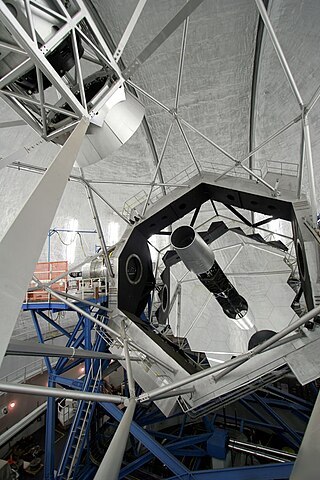Top Qs
Timeline
Chat
Perspective
Zerodur
Extremely durable glass-ceramic From Wikipedia, the free encyclopedia
Remove ads
Zerodur is a lithium-aluminosilicate glass-ceramic manufactured by Schott AG. Zerodur has a near zero coefficient of thermal expansion (CTE), and is used for high-precision applications in telescope optics, microlithography machines and inertial navigation systems.

Remove ads
Manufacturing process
Zerodur is produced in a two-step process involving melting and ceramization. Depending of the size of the blanks, each step can take several months.[2]
First, raw materials including main components of lithium oxide (Li2O), alumina (Al2O3), and silica (SiO2) are melted at high temperatures of around 1600 °C, poured into molds, and annealed in a controlled cooling process that relieves internal stresses that develop during forming.[3][4] Then the glass undergoes a ceramization process involved controlled volume crystallization, which creates high-quartz nano-crystallites of 30 nm to 50 nm.[2] The negative CTE of the crystals compensates for the positive CTE of the residual glass matrix, which gives Zerodur its near zero thermal expansion.[4]
Remove ads
Applications

The main applications for Zerodur include telescope optics in astronomy[5] and space applications,[6] lithography machines for microchips and displays,[7] and inertial measurements systems for navigation.[8][9]
In astronomy, it is used for mirror substrates in large telescopes such as the Hobby-Eberly Telescope,[10] the Keck I and Keck II telescopes,[11] the Gran Telescopio Canarias,[12] the Devasthal Optical Telescope,[13] the European Southern Observatory's 8.2 m Very Large Telescope,[14] and the 39 m Extremely Large Telescope.[15] It also has been used for the primary mirror of SOFIA's airborne telescope.[16]
ASA also produces some telescopes with zerodur.[17]
In space, it has been used for the imager in Meteosat Earth observation satellites,[18] and for the optical bench in the LISA Pathfinder mission.[19]
In microlithography, Zerodur is used in wafer steppers and scanner machines for precise and reproducible wafer positioning.[20][21] It is also used as a component in refractive optics for photolithography.[22]
In inertial measurement units, Zerodur is used in ring laser gyroscopes.[23]
Remove ads
Properties
Zerodur has both an amorphous (vitreous) component and a crystalline component. Its most important properties[24] are:
- The material exhibits a particularly low thermal expansion, with a mean value of 0 ± 0.007×10−6 K−1 within the temperature range of 0 to 50 °C.[25]
- High 3D homogeneity[25] with few inclusions, bubbles and internal stria.
- Hardness similar to that of borosilicate glass.
- High affinity for coatings.
- Low helium permeability.
- Non-porous.
- Good chemical stability.
- Fracture toughness approximately 0.9 MPa·m1/2.[26][27]
Physical properties
- Dispersion: (nF − nC) = 0.00967
- Density: 2.53 g/cm3 at 25 °C
- Young's modulus: 9.1×1010 Pa
- Poisson ratio: 0.24
- Specific heat capacity at 25 °C: 0.196 cal/(g·K) = 0.82 J/(g·K)
- Coefficient of thermal expansion (20 °C to 300 °C) : 0.05 ± 0.10×10−6/K
- Thermal conductivity: at 20 °C: 1.46 W/(m·K)
- Maximum application temperature: 600 °C
- Impact resistance behavior is substantially similar to other glass[28]
History
Schott began developing glass-ceramics in the 1960s lead by Jürgen Petzoldt, in response to demand for low expansion glass ceramics for telescopes.[29]
In 1966, Hans Elsässer, the founding director of the Max Planck Institute for Astronomy (MPIA), asked the company if it could produce large castings of almost 4 meters using low-expansion glass-ceramic for telescope mirror substrates. In 1969, the MPIA ordered a 3.6 m (12 ft) mirror blank, along with ten smaller mirror substrates. The mirrors were delivered by late 1975,[29] and went into operation in 1984 in a telescope at the Calar Alto Observatory in Spain. Further orders for mirror blanks followed.[30]
Remove ads
See also
References
External links
Wikiwand - on
Seamless Wikipedia browsing. On steroids.
Remove ads
